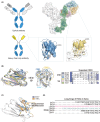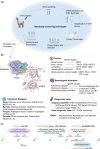Single domain antibody: Development and application in biotechnology and biopharma
- PMID: 39166870
- PMCID: PMC11659936
- DOI: 10.1111/imr.13381
Single domain antibody: Development and application in biotechnology and biopharma
Abstract
Heavy-chain antibodies (HCAbs) are a unique type of antibodies devoid of light chains, and comprised of two heavy chains-only that recognize their cognate antigen by virtue of a single variable domain also referred to as VHH, single domain antibody (sdAb), or nanobody (Nb). These functional HCAbs, serendipitous discovered about three decades ago, are exclusively found in camelids, comprising dromedaries, camels, llamas, and vicugnas. Nanobodies have become an essential tool in biomedical research and medicine, both in diagnostics and therapeutics due to their beneficial properties: small size, high stability, strong antigen-binding affinity, low immunogenicity, low production cost, and straightforward engineering into more potent affinity reagents. The occurrence of HCAbs in camelids remains intriguing. It is believed to be an evolutionary adaptation, equipping camelids with a robust adaptive immune defense suitable to respond to the pressure from a pathogenic invasion necessitating a more profound antigen recognition and neutralization. This evolutionary innovation led to a simplified HCAb structure, possibly supported by genetic mutations and drift, allowing adaptive mutation and diversification in the heavy chain variable gene and constant gene regions. Beyond understanding their origins, the application of nanobodies has significantly advanced over the past 30 years. Alongside expanding laboratory research, there has been a rapid increase in patent application for nanobodies. The introduction of commercial nanobody drugs such as Cablivi, Nanozora, Envafolimab, and Carvykti has boosted confidence among in their potential. This review explores the evolutionary history of HCAbs, their ontogeny, and applications in biotechnology and pharmaceuticals, focusing on approved and ongoing medical research pipelines.
Keywords: VHH; biotechnological tools; diagnosis; heavy chain antibodies; nanobody; single‐domain antibody; therapeutics.
© 2024 The Author(s). Immunological Reviews published by John Wiley & Sons Ltd.
Conflict of interest statement
The authors declare that the research was conducted in the absence of any commercial or financial relationships that could be construed as a potential conflict of interest.
Figures



Similar articles
-
Nanobodies: natural single-domain antibodies.Annu Rev Biochem. 2013;82:775-97. doi: 10.1146/annurev-biochem-063011-092449. Epub 2013 Mar 13. Annu Rev Biochem. 2013. PMID: 23495938 Review.
-
Nanobodies: From Serendipitous Discovery of Heavy Chain-Only Antibodies in Camelids to a Wide Range of Useful Applications.Methods Mol Biol. 2022;2446:3-17. doi: 10.1007/978-1-0716-2075-5_1. Methods Mol Biol. 2022. PMID: 35157266
-
Applications of nanobodies in plant science and biotechnology.Plant Mol Biol. 2021 Jan;105(1-2):43-53. doi: 10.1007/s11103-020-01082-z. Epub 2020 Oct 10. Plant Mol Biol. 2021. PMID: 33037986 Free PMC article. Review.
-
Single Domain Antibody application in bacterial infection diagnosis and neutralization.Front Immunol. 2022 Sep 29;13:1014377. doi: 10.3389/fimmu.2022.1014377. eCollection 2022. Front Immunol. 2022. PMID: 36248787 Free PMC article. Review.
-
Introduction to heavy chain antibodies and derived Nanobodies.Methods Mol Biol. 2012;911:15-26. doi: 10.1007/978-1-61779-968-6_2. Methods Mol Biol. 2012. PMID: 22886243 Review.
Cited by
-
Development of potent humanized TNFα inhibitory nanobodies for therapeutic applications in TNFα-mediated diseases.MAbs. 2025 Dec;17(1):2498164. doi: 10.1080/19420862.2025.2498164. Epub 2025 May 14. MAbs. 2025. PMID: 40367237 Free PMC article.
-
Highly Potent Neutralizing Nanobodies Acting Against Chikungunya Virus Infection via Inhibiting Multiple Stages of the Viral Life Cycle.Int J Mol Sci. 2025 Apr 23;26(9):3982. doi: 10.3390/ijms26093982. Int J Mol Sci. 2025. PMID: 40362222 Free PMC article.
-
Alkaline phosphatase-streptavidin conjugate (APSA) enzyme and binding activity over time and storage conditions.Biochem Biophys Rep. 2025 Jul 21;43:102160. doi: 10.1016/j.bbrep.2025.102160. eCollection 2025 Sep. Biochem Biophys Rep. 2025. PMID: 40718384 Free PMC article.
-
Future of bNAbs in HIV Treatment.Curr HIV/AIDS Rep. 2025 May 27;22(1):34. doi: 10.1007/s11904-025-00744-1. Curr HIV/AIDS Rep. 2025. PMID: 40423754 Free PMC article. Review.
-
Evidence for a model of conformational change by the Plasmodium falciparum circumsporozoite protein during sporozoite development in the mosquito host through the use of camelid single-domain antibodies.Infect Immun. 2025 Jun 10;93(6):e0008125. doi: 10.1128/iai.00081-25. Epub 2025 Apr 28. Infect Immun. 2025. PMID: 40293231 Free PMC article.
References
-
- Agnew D. Chapter 7 ‐ Camelidae. In: Terio KA, McAloose D, Leger JS, eds. Pathology of Wildlife and Zoo Animals. Academic Press; 2018:185‐205.
-
- Hamers‐Casterman C, Atarhouch T, Muyldermans S, et al. Naturally occurring antibodies devoid of light chains. Nature. 1993;363(6428):446‐448. - PubMed
-
- Blanc MR, Anouassi A, Ahmed Abed M, et al. A one‐step exclusion‐binding procedure for the purification of functional heavy‐chain and mammalian‐type gamma‐globulins from camelid sera. Biotechnol Appl Biochem. 2009;54(4):207‐212. - PubMed
Publication types
MeSH terms
Substances
Grants and funding
LinkOut - more resources
Full Text Sources
Miscellaneous

